Do you ever go out photographing landscapes when the weather isn’t that great? I think most photographers prefer a sunset with intense colors and playful clouds. But perhaps you should try bad weather for a change.
We all love pictures of sunsets or sunrises, with a beautiful sky full of wonderful colors and clouds. And it is true, sunsets and sunrises can be amazing. I know a lot of landscape photographers that prefer to shoot these kind of images, and some of them never go out when the forecast is predicting bad weather. These photographers stay inside when rain is imminent, longing for another perfect sunset.

A perfect sunrise, with an almost cloudless sky and fog. This is what we all want in a landscape. But there is more than this (Canon EOS 5D4 70mm | ISO100 | f/11 | 1/400)
I can understand a lot of photographers prefer to stay inside during bad weather conditions. We have expensive photography equipment, that makes use of electricity. And we all know water and electricity aren’t the best of friends. Manufacturers of cameras and lenses tell about how weather resistant their products are, and yet we hesitate to believe them, and rather prevent it from getting wet. Just imagine, if it gets damaged due to rain or water.
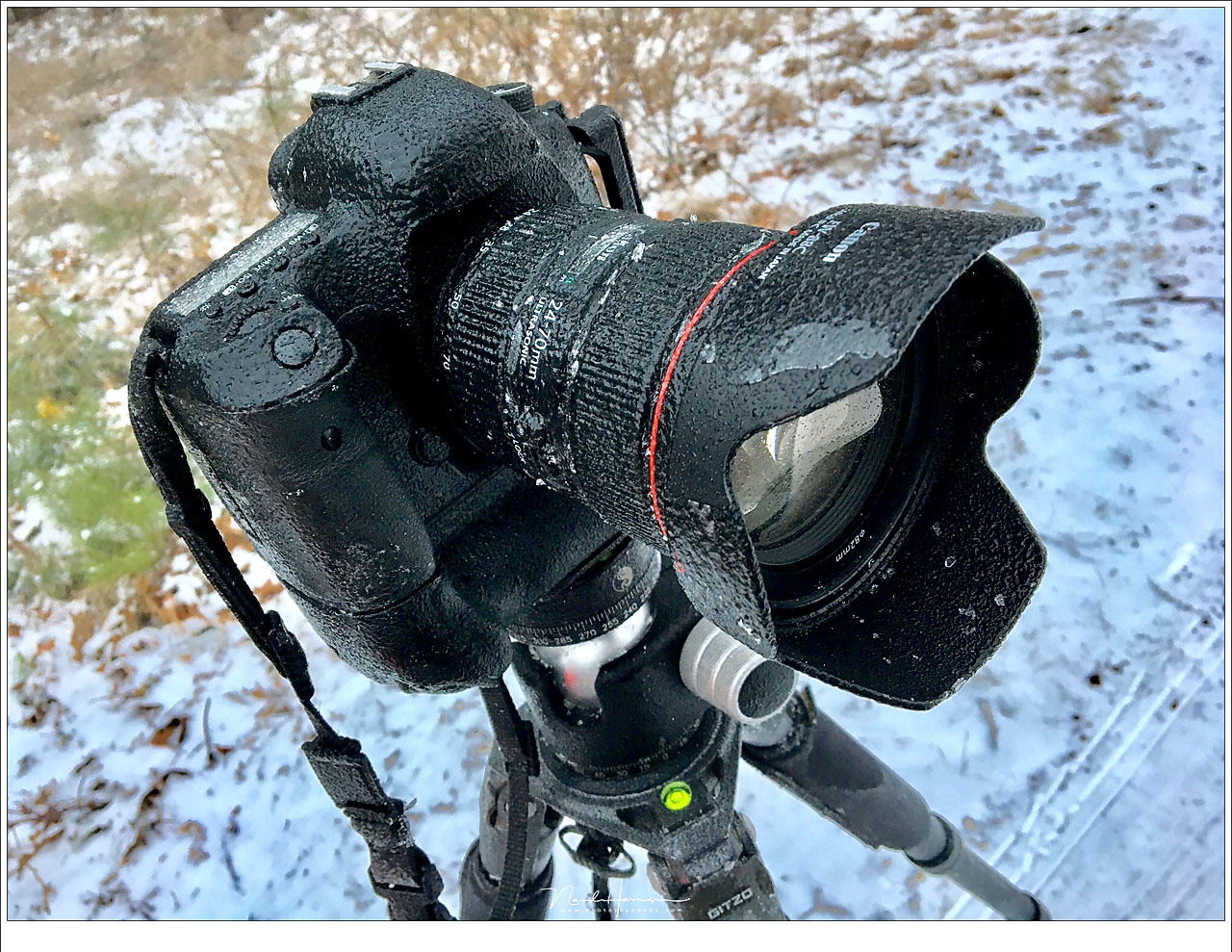
My camera covered with sleet. I never had my camera covered in ice like this, but it kept on working without problem. The only concern is to keep the lens free from condense, ice and water drops.
And yet, bad weather can produce the most interesting images. Dark and dramatic clouds, rain showers, and landscapes that change every second can be wonderful to shoot. Yes, we might get wet, just like our camera, but there are ways to deal with it. You need to make a few preparations to go out shooting in bad weather.
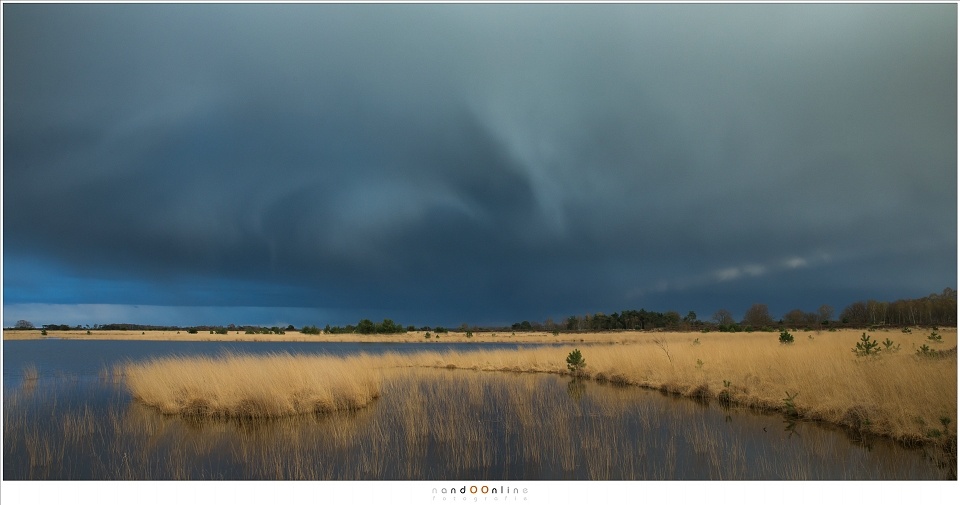
Clouds filled with rain, take on amazing forms and patterns. (Canon EOS 1Dx 24mm | ISO400 | f/8 | 1/100)
First thing you need to know, is how weather proof your camera is. You don’t need to hold it under the shower until it dies, but you need to know what the manufacturer claims. If it isn’t weather resistant you need to be more cautious. There are rain covers available, and even a shower cap or simple plastic bag can do wonders. If you are wearing a poncho, you can keep your camera underneath it, just taking it out for that one shot. A few drops of water won’t hurt your camera that much. Just don’t get it soaked.

While testing the Panasonic Lumix DC-G9 I wasn't afraid of a rain shower. And indeed, the camera kept on working without a problem.
There is a thing to be aware of when using rain covers. I once had my camera on tripod during a rain shower. When it began pouring rain I decided to put inside a rain cover. It stayed there for about ten minutes and when I wanted to take another picture, the camera wasn’t responding that well. Then I realized my mistake: I placed a almost soaked camera in the rain cover, preventing the moisture from escaping. So I learned an important lesson; do not place a wet camera in a bag. I should have kept my camera in the rain, or I should have placed the rain cover before it became too wet. Fortunately after I removed it from the rain cover and let it dry, everything worked flawlessly.

I don't mind when my camera is getting wet, like this Canon EOS 1Dx and EF24-70mm lens. As long as you don't put it in a bag or rain cover, so I learned.

A rain cover can protect your gear and you still be able to use it. It not only protects against water, but sand also, like on a beach during a storm. You might also use a shower cap or plastic bag.
A rain cover may lead to hindrance, and it may be a nuisance to shoot with it, but that is something you can deal with. Just take your time and don’t be hasty when shooting in the rain. Ah yes, and make sure you wear weather protective clothing also. You need to keep dry and warm.
I love using a filter system for my landscape photography. But during rain showers this may be nearly impossible. Raindrops on your lens and filter are the biggest problems, and you have to try to prevent any rain from falling onto the lens. I always have a dishcloth with me, to wipe the lens or filter in case it gets wet. A microfiber cloth does not work for wet surfaces. Using a lens hood can help protecting the lens from raindrops, and place your lens cap if you walk around. But again, make sure no water is trapped between lens and lens cap.

I find rain drops on the lens the biggest problem while shooting in the rain. A dishcloth can help wiping the lens. It also helps when using filters.
When shooting in the rain, take a more than a few pictures of a scenery, each time wiping the lens in between. Shooting from a tripod may help keeping the same composition. The only filter I would recommend is a polarization filter, that can help bringing out colors and contrast, and prevent reflections. A polarization filter like a Lee Landscape Polarizer may be unsuitable, since it so large and requires a filter holder, but a small filter in the filter threat of the lens is better. I use the Kase filter system that makes use of a magnetic polarization filter on the adapter ring, that I find very convenient. On the other hand; I also used the LucrOit filter holder with the sun flaps, that also gives some protection against raindrops

This is me, shooting in the rain during my Faroër trip in 2018. I used a filter holder of LucrOit with flaps that protected the lens from the rain. (photo by Hetwie (www.hetwie.hl))
It is advisable to go out with the least amount of gear. You don’t want to change lenses in the rain, or grabbing something from your backpack. I find a 24-70 mm and 70-200 mm a wonderful set for shooting in the rain, and most of the times you don’t need anything else. Sometimes a shoulder bag with a rain cover can be most handy, and you can keep it even under a rain poncho, making it possible to change a lens even during a rain shower. Practice this at home before you go out.
Using a tripod is good for shooting with low ISO values during the mostly dark weather situations, but sometimes it can be cumbersome to use under rainy conditions. Don’t hesitate to use high ISO values if you find the tripod a nuisance. Most modern cameras have no problem with ISO 1600, ISO 3200 or even ISO 6400. I like the auto-ISO option of my camera when shooting hand hold, so I don’t have to worry about that. I just take my camera from under my poncho, point and shoot with the aperture I want, and cover it again.
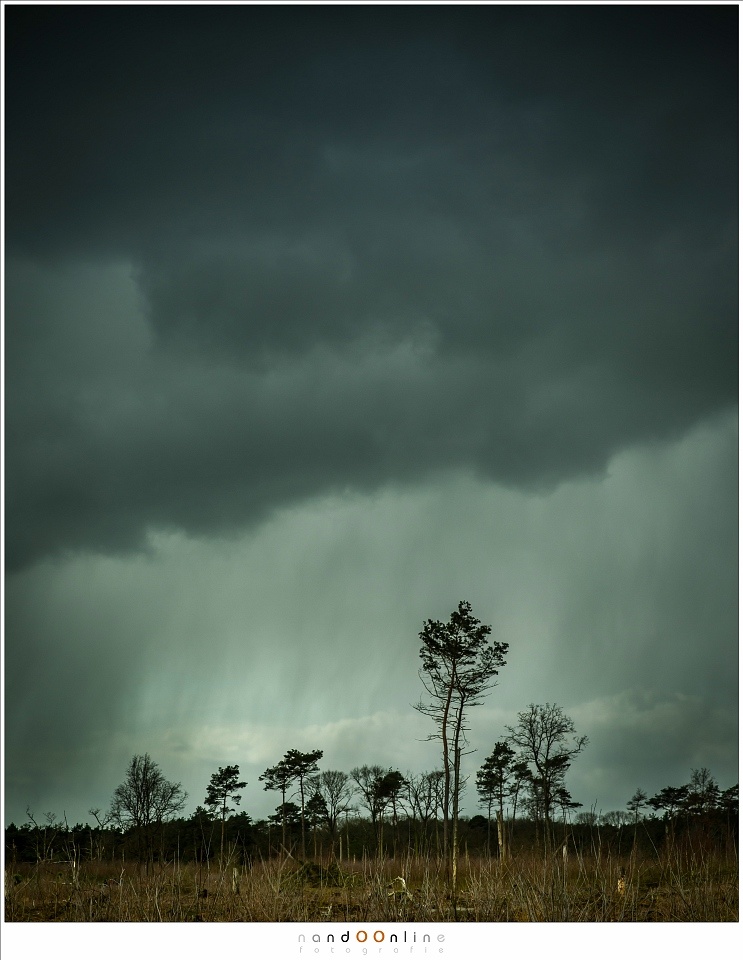
When the light is right, you can actually see the falling rain. I kept my camera under my poncho, taking it out long enough to shoot this photo. (Canon EOS 5D3 65mm | ISO200 | f/3,2 | 1/1600)
But most of the times it isn’t raining all day long. Rain showers come and go, and in between the skies can be quite dramatic. Sometimes the sun will break through the clouds, flooding a landscape with amazing light. You might get lucky and spot a rainbow.
Bottom line, you just have to ignore the rain and go out for the amazing landscapes that unfold during the days of bad weather. And who knows, when the day comes to and end, and the sun peeks underneath the clouds, you might be rewarded with a burst of light with immense beauty.

After a day with lots of rain, the twilight exploded with red clouds. It was truly amazing. This light lasted for only a minute and I would have missed it when I decided to stay at home due to the rain. (Canon EOS 5D3 70mm | ISO400 | f/8 | 1/60)

Amazing light during sunset, with anti-crepuscular light rays opposite to the sun. The light is reflected in the rain clouds at the horizon. (Canon EOS 5D3 50mm | ISO200 | f/8 | 1/80)
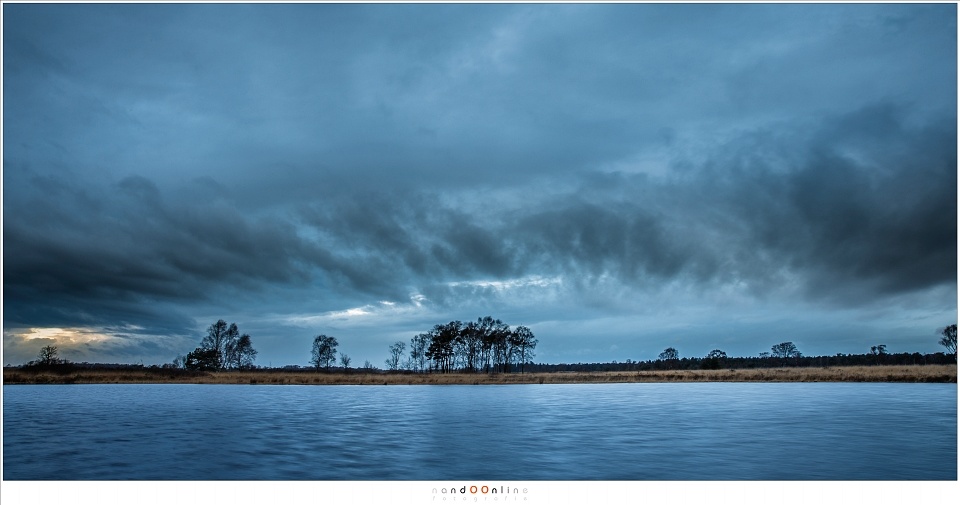
Beautiful patterns in the clouds on this rainy evening. (Canon EOS 1Dx 24mm | ISO50 | f/16 | 1,3sec)

A dark cloud is comming in, with lots of rain. Most of the time these rain showers are only a few minutes long. During these days there is a change of seeing and photographing a rainbow, so don;t find shelter at home or you miss it. (Canon EOS 5D3 33mm | ISO100 | f/8 | 1/125)

You might see amazing cloud formations, like these beginning mammatus clouds. These clouds can take amazing forms. (Canon EOS 5D3 70mm | ISO100 | f/8 | 1/200)
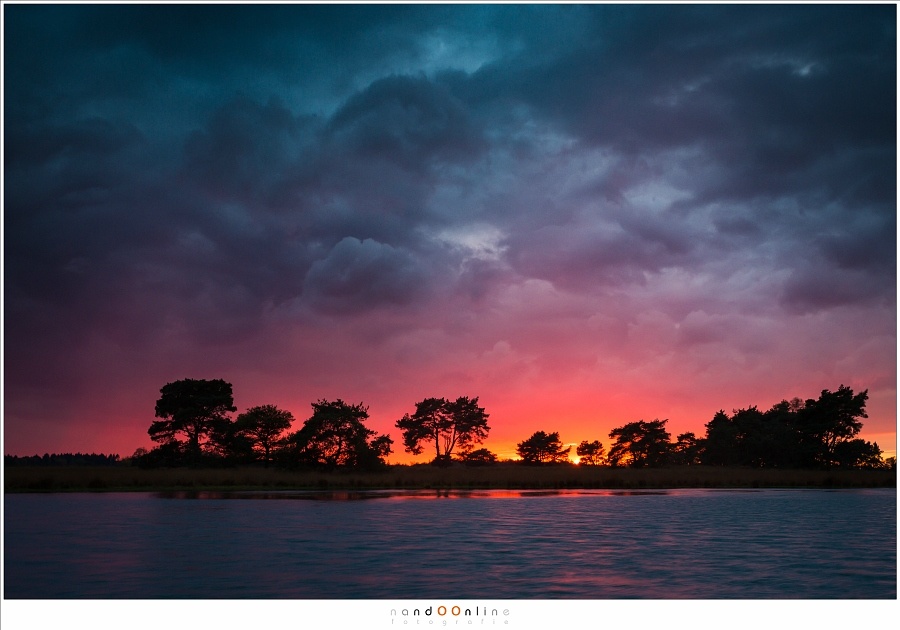
When the sun is reaching the horizon, its light can find a way under the clouds.These moments are amazing (Canon EOS 5D3 40mm | ISO200 | f/8 | 0,8sec)
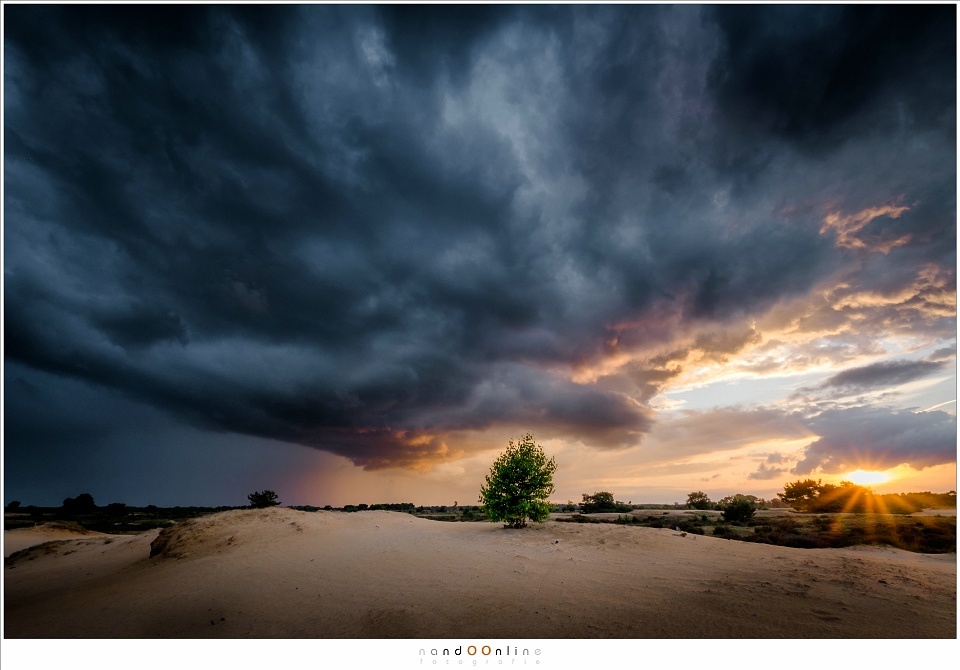
These are the moments I prefer. Thick rain clouds and clear skies during sunset. You have to be at the location before this happens, even when it means to go out when it is still raining. (Fujifilm X-Pro2 10mm | ISO200 | f/16 | 1/10)
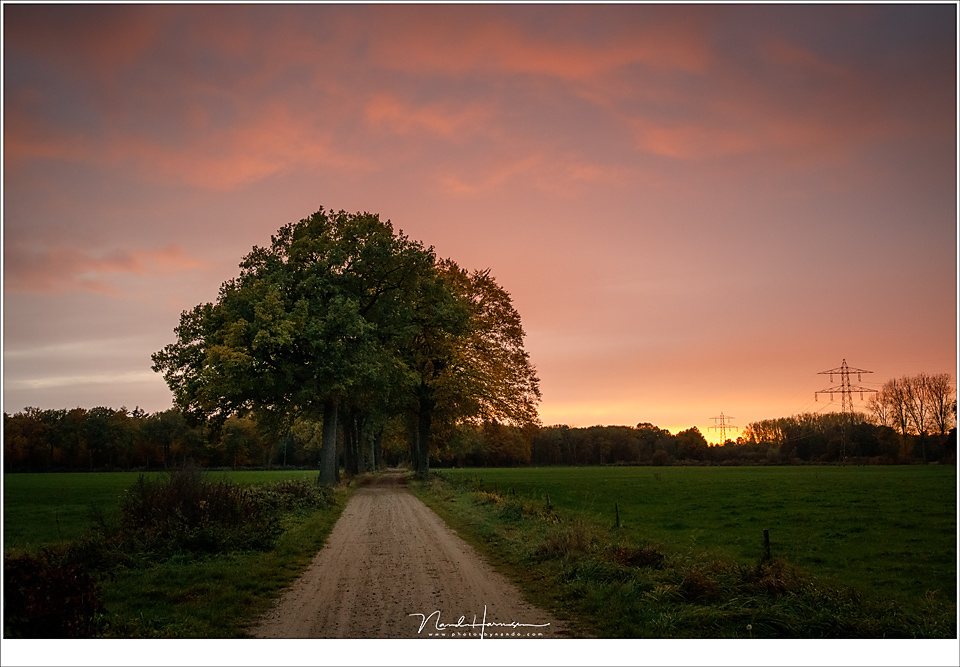
It was raining all day, but during sunset the sky became orange for just a few minutes. Since I did not have my tripod with me, I used the high ISO capabilities of the camera (Canon EOS R 35mm | ISO3200 | f/8 | 1/60)
Are you only shooting landscapes with nice sunny weather conditions, or do you take your changes with so called bad weather? And if you do, what kind of precautions do you take for your equipment? I love to read about it in the comments.







Wonderful article! I'm headed for a 2 week trip to the Philippines and this made me feel better about facing bad weather! Cheers!
bad weather creates better pictures, is something I always thought. Nice article, very direct with awesome pictures. Congrats, it just snapped my will to go behind bad weather again after a while
Brilliant article with amazing images. Now I will look forward to a rainstorm.